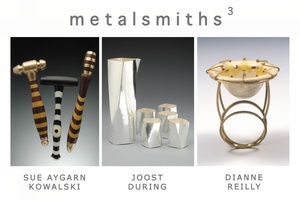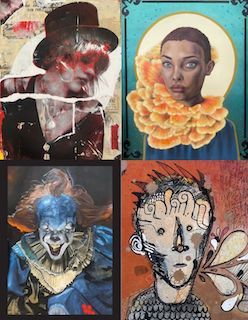The Narrows Gallery proudly presents metalsmiths3, featuring the artwork of
Sue Aygarn-Kowalski, Joost During and Dianne Reilly, who share an absolute passion for metal as well as a studio space. By working with the traditional techniques, methods and visual language of metalsmithing, these artists explore themes of form, function and understanding. Through the process of making and visual qualities, the work invites one to pause, observe and experience in an increasingly transitory culture of the mass-produced object.
The artwork on exhibit, both functional and non-functional, in the forms of vessels, tools, sculpture, and jewelry articulate the value of expressive hand-made one-of-a-kind objects in an increasingly computerized culture. metalsmiths3 will be on exhibition in the Narrows Gallery
September 1 ‘ October 24, 2009.
The Opening Reception will be held on Sunday, September 20, 2009 from 2:00 ‘ 5:00 p.m. The public is cordially invited to attend. Admission is free.
The Narrows Gallery is located in the Narrows Center for the Arts, 16 Anawan Street, Fall River, MA. Gallery Hours are Wednesday ‘ Saturday, Noon ‘ 5:00 and by appointment. Admission is free during regular Gallery Hours. All concert ticket-holders are welcome to view the exhibition on performance night. For more information: Website: www.ncfta.org / Email: publicrelations@ncfta.org / Phone: 508.324.1926
ARTISTS’ STATEMENTS
Sue Aygarn-Kowalski ‘ Jewelry, Metals, Sculpture
My work takes the form of functional tools for the hand in metal, wood, and plastic. They are an argument for aesthetic experience over speed and efficiency, for skill over blind use, for self-reliance over dependencies, and for an absolute love of process. Like bookends, ideas concerning the hand and the informing sense of touch act as a nurturing cradle for my work. The objects I make result from my need to live actively, physically, and tactilely in an increasingly computerized world, and I offer my work as a counterpoint to digital culture.
I believe that through the combination of hand and mind the most powerful resource in the evolution of humans emerged – the ability to fabricate and to use tools. The result was and continues to be, the ability to affect, guide, and in large degrees to control (for better or worse) the conditions that make up both our physical and social environments. This belief drives my artistic desire to celebrate the direct, self-informing, and tactile relationship between hand, tool and user.
Joost During – Silversmith
I enjoy the challenge of making functional objects. An important aspect of an object’s functionality for me is the pleasure of using it.
I begin a design with lines inspired by nature on a piece of paper. During the process of hammering and shaping I follow the natural tendencies of the metal to eventually arrive at the final form. I approach each piece this way considering how its form aids its use as well as its visual appeal.
I feel a strong connection to craftspeople from the past, using the same techniques and tools, carrying on a tradition. I am interested in providing and creating objects to live with that offer an aesthetic aspect to every day life.
Dianne Reilly ‘ Jewelry, Metals, Sculpture
I am interested in that moment when we pause to really look at something, try to understand it, and connect to it in some way. We dissect the whole and try to connect the parts to something or some one that we know.
At times when we are focused in a certain way there is a connection to something internal and intangible. We feel it when it happens; the small hairs on the back of the neck tingle and move, skin becomes gently electrified as if it were trying to allow something to pass through, a small lump forms at the base of the trachea as if to halt the possibility of verbalization. The eyes nose and begin to water seemingly in order to create a barrier between two worlds. It is involuntarily physical and often causes the response of retreat.
In my work I create references to the triggers and the mechanisms of this process. At times it is the shape of an eye combined with visceral surfaces and representations or interpretations of receptacles and triggers (small dots and vessels that connect on the molecular level of understanding). At other times it may be asking the viewer to physically take part in peeling away those external layers to take a moment to gaze, to observe, to understand.






